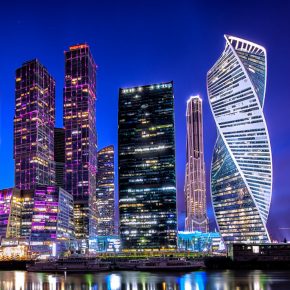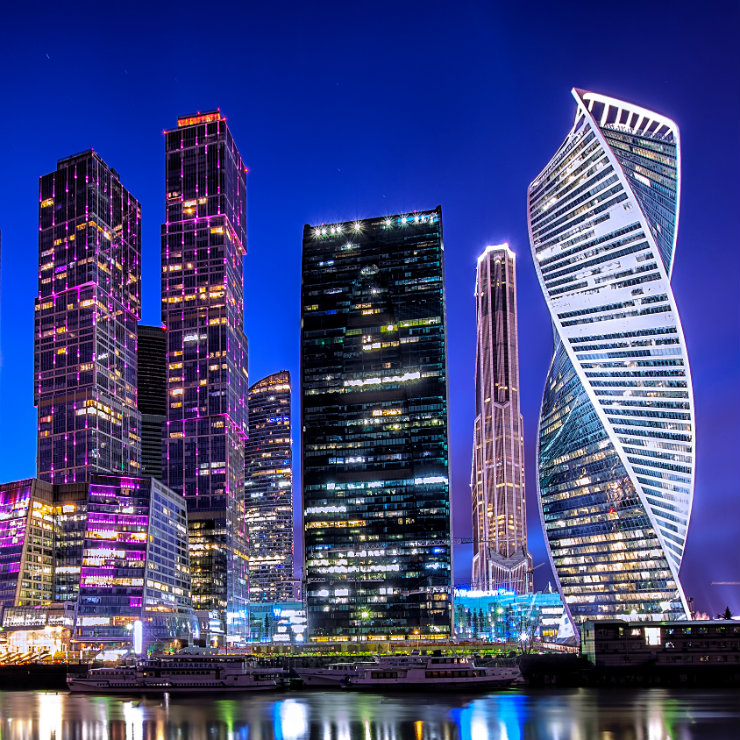
Moscow International Business Center, Russia (Miguel Sala, CC BY-NC-ND)
Russia has a flair for formulating multi-annual, exceedingly ambitious socio-economic programs, which are often impossible to implement already at the time of their announcement. This is the result of a detachment of the established goals and tasks from the reality and the economic conditions on the ground.
One example of that problem could be the „Russia 2020” program, adopted in December 2008. Its goal was to „achieve the level of economic and social development, corresponding with Russia’s status as a leading world power of the 21st century”. By 2020, Russia was supposed to join the group of five countries leading the world in terms of the size of their GDP. The achievement of such a level of development would be guaranteed with an average annual GDP growth rate of 6.5 per cent. However, the strategy was detached from reality already at the time of its adoption, especially that this occurred during the intensifying global financial crisis. In reality, in the years 2009-2017 the rate of GDP growth in Russia reached an average level of 0.7 per cent, and probably won’t exceed 1 per cent in the entire period covered by the program, that is, until 2020. As a result, instead of entering the top five, Russia will be ranked between 12th and 14th in terms of GDP (in 2008 it was ranked 7th).
Suffering from stagnation
Russia’s currently implemented development program, covering the period until 2024, is just as ambitious as the goal of joining the group of the five largest economies in the world. However, the analysts are pointing out, that a country with a GDP growth rate much lower — in some years even twice lower — than the global average, is not able to improve its position in the global economy. In order to do that, Russia would need economic growth at the rate of 5-6 per cent per year, rather than the current rate of 1-2 per cent or even the rate of 2-3 per cent, which is seen as a rather unrealistic goal for the years after 2020.
Russia’s long-term Finance Minister and the current Chairman of the Accounts Chamber, Alexei Kudrin, has presented a grim assessment in the discussion concerning the economic program, the established goals and the mechanisms for achieving them. He believes, that the growth potential of the Russian economy does not exceed 1 per cent per year. Mr. Kudrin also indicated that Russia has found itself in „an unprecedented stagnation pit, and the economy has been unable to get out of it for the past 10 years”.
Strong foundations
The main pillars of Russian economic programs, including those implemented currently, include the acceleration of the rate of growth and maintaining the country’s pro-social economic policy. In practice, however, the implemented measures are not conducive to the achievement of both of these objectives and may even hinder it.
The analysts use international comparisons to point out the strong internal foundations of the Russian economy, such as the high budget surplus (3.7-4 per cent of the GDP), the high positive current account balance (USD104.3bn for the period from January to November 2018), the low level of public debt (about 15 per cent of the GDP), the relatively low inflation (3.7 per cent at the end of November 2018). The external conditions, apart from the sanctions, are also seen as beneficial for the Russian economy. This applies in particular to oil prices, which are now at a higher level than that assumed in the economic programs. In this context, the analysts are struggling to identify the reasons why Russia’s rate of economic growth is persistently lower than the potential growth. The differences in this regard are estimated to reach 2-4 percentage points (such a disparity is indicated by the analysts at Standard & Poor’s).
According to analysts, the fault mainly lies with the government, whose activities are pushing the Russian economy towards a recession. The development opportunities are primarily weakened due to the implementation of Russia’s budgetary principle, which is seen by many as dogmatic. According to the aforementioned rule, all budget revenues resulting from an increase in the oil prices above the threshold of USD40 per barrel (in 2017 prices, adjusted annually by 2 per cent, which gives a price of USD40.8 in 2018) are allocated for the purchase of currencies supplying the National Welfare Fund, until the value of its accumulated resources reach 7 per cent of the GDP. In this way, the creation of a „cushion” ensuring stability in the event of a possible future decline in the oil prices and the tightening of sanctions gained priority over the current development needs of the Russian economy. Based on the existing budgetary mechanism, during the first eleven months of 2018 the high price of crude oil generated additional revenues of RUB2.5 trillion (over USD40bn) for the National Welfare Fund. As of November 1st, 2017, the National Welfare Fund accumulated RUB4.6 trillion (USD68.5bn), which amounts to 4.6 per cent of the GDP.
Another questionable decision of the government is the increase of the VAT from 18 to 20 percent starting from January this year. The analysts have been critical of the economic justification for the decision, indicating, that it is being implemented in conditions of a significant budget surplus, and that the additional budgetary revenues in this amount of RUB600bn will result in a simultaneous reduction of consumption by the same amount. This is especially important in light of the fact, that entrepreneurs are identifying insufficient growth of consumption as one of the main reasons for their low investment activity. Weak investment, in turn, is widely seen as the main reason for Russia’s economic slowdown. This means, that with its own decisions, the Russian government is weakening the very thing that its own economic programs identify as the leading factor accelerating the rate of economic growth, i.e. investments, including investments financed from the budget on the basis of a public-private partnership. On this occasion, the experts have been recalling the decision from 2004, when the VAT rate was reduced from 20 per cent to 18 per cent. At that time, the Ministry of Finance justified the move as necessary to support investment and pointed out the good condition of the state budget. Today, it pursues the reverse course of action despite the fact that similar circumstances prevail.
The decision will have a measurable negative effect, which has also been indicated in government forecasts: the rate of GDP growth will slow down from 1.7-1.8 per cent in 2018 to 1.3 per cent in 2019, instead of accelerating to above 2 per cent, as has been assumed previously.
The analysts are going further in their assessments, pointing out that the cumulative effect of the VAT increase — resulting in higher inflation and a decline in the rate of consumption growth by 2 percentage points — will be a further weakening of the GDP growth rate to 0.8 per cent in 2019.
More state aid, lower incomes of the citizens
A significant discrepancy and lack of correlation between the official declarations and the actions and decisions of the government is also noticeable with regards to the supposed pro-social nature of Russia’s economic development, whose main objective is the fight against poverty. As a result of the increasing generosity of the state budget, the share of funds derived from social welfare in the incomes of Russian citizens increased from 13.2 per cent in 2008 to 19.7 per cent in 2017. At the same time, however, the real incomes of the population have decreased by 11 per cent over the last four years. The situation in this respect will not improve in 2018 either, despite a wide variety of considerable one-off payments from the budget before the presidential elections held in March. In November 2018, the real incomes of Russians fell by 2.9 per cent y/y, and 2018 may turn out to be the fifth year in a row with decreasing incomes. The analysts do not see any significant reasons for this trend to change in the coming years.
It is emphasized, that the decline in the real incomes of the population has been taking place in conditions of a significant slowdown in inflation, which fell to 2.5 per cent in 2017 compared with 11.4 per cent in 2014. In 2018, inflation may exceed 4.2 per cent. According to widespread estimates, the VAT increase will cause the inflation to rise to 5.5-6 per cent in 2019.
If the real incomes of the population had been decreasing in conditions of falling inflation, it would be difficult to expect them to increase once inflation accelerates. A further decline in incomes will lead to an increase in poverty Russia, which could affect up to 20 million people. According to official data, persons with incomes below the subsistence level already account for 12.3 per cent of Russia’s entire population.
The central bank supports the government but not the economy
The activities of the Central Bank of Russia (CBR) are geared towards the achievement of the official inflation target which is set at 4 per cent. CBR’s base interest rate policy is subordinated to the achievement of that goal. CBR is widely criticized for keeping the interest rate at an excessively high level, which increases the cost of loans, which in turn translates into a rate of economic growth that is lower than country’s potential.
CBR has increased its base interest rate twice in 2018 (for the first time in September, from 7.25 to 7.50 per cent). The latest hike from 7.50 to 7.75 per cent, carried out in mid-December 2018, has been associated with the bank’s expectation of a rise in inflation resulting from the VAT increase. However, the analysts do not see any fundamental rationale for such a decision, and are pointing out the contradictions and lack of consistency in CBR’s activities.
Since February 2017, CBR has been purchasing foreign currencies on the domestic market at the request of the Ministry of Finance. For this purpose it has allocated the amount of RUB912bn (about USD15.6bn) in 2017, and RUB4 trillion (about USD64bn) in 2018. Such a scale of intervention on the currency market is an important factor in the weakening of the RUB’s exchange rate, especially considering the fact, that until August 2017 these transactions were conducted on the open market (since September 2017, the purchases have been made from the CBR’s own resources). The weakening exchange rate of the RUB is an important factor strengthening inflation (read more). CBR has even pointed this out in its own analyses. The Governor of the Central Bank of Russia Elvira Nabiullina estimates, that the devaluation of the RUB is responsible for 0.9 percentage point of the inflation rate in 2018.

